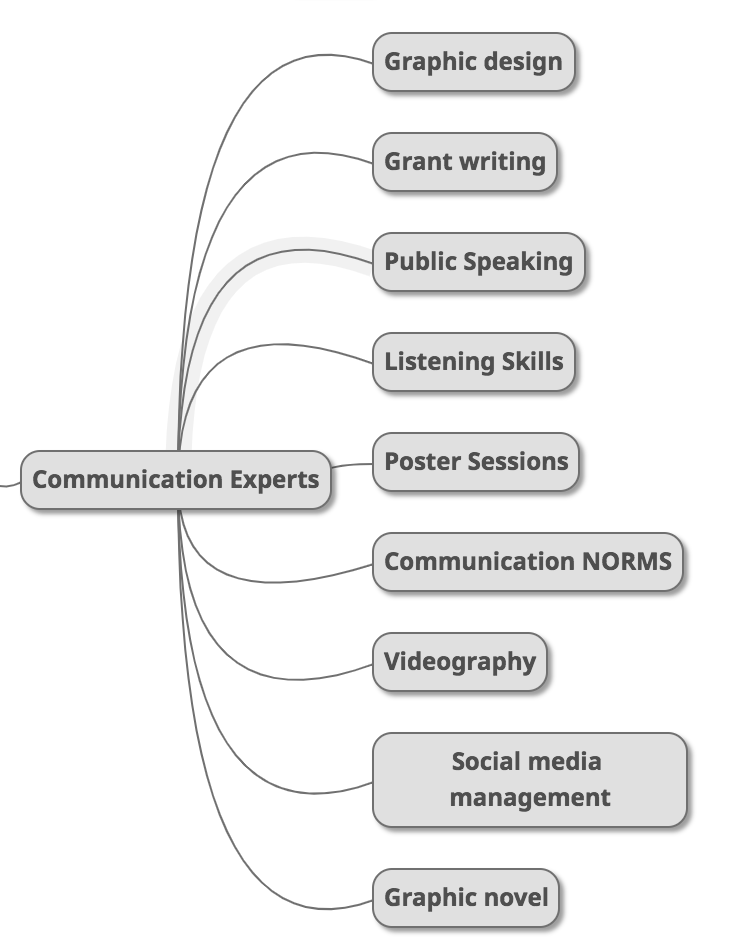The community engagement process can be a daunting task to start.
Student preparation means that you have created a safe learning environment and helped students maintain a growth mindset. This means primarily that you constantly celebrate speech patterns that support a growth mindset. It also means that they have “played” with enough technology to feel that they have the ability to creatively apply it in a variety of situations. Activities in the kits will help with this, but so do icebreakers that involve working together and connecting with others. Make sure to include time to play and try stuff – don’t rush tech skills training. Teach the design thinking process, and guide them along every step of the way. The process is pregnant with opportunities to practice communication and teamwork skills.

We will have guides to help with the communication skills. The most important one that students should practice is the skill of listening. Below is a graphic showing other skills that should be taught as needed. We work with communication experts to get tips and tricks for the best ways to help guide students as they go through this. It is important that you introduce topics when there is a context for learning about it.

Introduce the Design Thinking process developed at Stanford and presented well in this crash course PDF. I have modified the design they use here to reflect a general T3 alliance project. We introduce the mini-grant proposal as a step right before a prototype phase. This is only necessary when the cost of building the prototype exceeds what you have on hand and consider consumable.
Program preparation:
The most important thing a program can do to support the community engagement process is cutting through the red tape that exists in any institution. Things that a program needs to do to prep, finding an appropriate learning space, preparing for local field trips, managing the finances for small-scale projects, helping with background checks for community members, managing equipment, and hiring capable staff with some sort of computer science background. Perhaps the most important aspect of a program is being ready to support student ideas for projects with immediate financial backing. The mini grant / deliverables process is very important.
Community preparation:
The community has always been key for societies to raise their youth. In many native cultures, there are stories of youth getting their first fish, or game animal, bringing it back to the village and being celebrated for the contribution they made to the survival of the community.
Learn your elevator pitch and be ready to tell anyone you meet about the what T3 alliance is about in under a minute. An “elevator pitch” is a term used to describe what you would say if you were in an elevator with an important job prospect or grant manager. They don’t know of you, so you have 60 seconds to sell your idea. You are leaving them with an opening to ask more, and possibly get involved. The image below shows an idea for redesigning our website – but it can be broken down into the pitch – the three big bubbles showing what we do and how it turns into studnet involvement in STEM career fields.

Once they are interested, outline what a specific commitment might look like and develop the relationship with attunement to safety, communication, and set up at least 3 opportunities for interaction. The first interaction does not need to be done in person, but it’s better if it can be. Here is an example of an interview we filmed for a possible client partnership with the Upward Bound Programs at UH Hilo and an astronomy project.
The second interaction should be somewhere around the testing phase. Once a project is developed. they should work together to analyze results to see if it fits the client’s needs. The last interaction should be a celebration of some sort. Presenting a completed project to an appreciative community member is an incredible experience for a group of students. If a potential client understands and can support this, then move forward, if not, gently separate yourself from the relationship.
GO Time:
Here are a few tips:
1: Remember why you are doing this – details can pop up that will frustrate you.
- Start small – Upward bound office, someone at the university, STEM friends, Non-Profits, Government organizations are all potential sites where you could find projects. Small and safe is a good first step. Over time, it will get more complicated. Every small success for a group of students builds confidence. We used selfie stations to get kids feeling the process.
- Teach when they need to know. Don’t teach writing skills until they need to write a proposal. As soon as you want them to use a video camera – teach what they need to know to produce the video you want them to have for a deliverable. Context is everything!
4. Trust the PROCESS. The design thinking process is a step by step guide. If you always come back to that you will be able to help every student redirect their actions.


